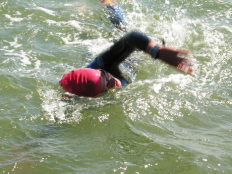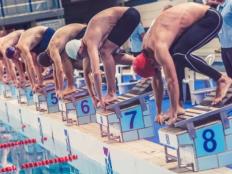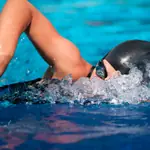Balance
Most athletes will have a tendency to favor one side. This imbalance can occur for many different reasons — crossing over, unequal pulling pressure, lopsided entry and excess head movement when breathing.
More: Kicking Drills for Better Body Position
Whatever the cause, the end result of an imbalance is that you go crooked. When your eyes are open in a swimming pool, it's easier to self-correct this crooked movement. However, when swimming in a cloudy lake or river where you can't see anything, it's not as easy to self correct and you may wind up veering way off-course.
Practice Set:
A simple way to self-diagnose if you have a tendency to swim crooked is to swim in a pool with your eyes closed. To get a true sense of your balance, it's important to keep your eyes tightly closed the entire time.
More: How to Keep Your Stroke Balanced
Often you will determine if you are going crooked by the first 10 strokes once you bump into the lane line. (Note: be careful of doing this in a crowded lane!)
Once you determine if you do have a tendency to swim a certain direction, you can take additional steps to reduce the imbalance. This will require individualized instruction.
If you don't have access to a swim coach, see if a friend will film you with a video camera or iPhone. Once you see yourself swim, it may be obvious why you are going crooked. Some imbalances are easy to fix, but others will be quite difficult. When it comes time to race, it's helpful to know if you have a tendency to swim in a certain direction so you can plan your strategy for the course.
For instance, if you tend to veer left and there is a current in a lake that is also pushing you left, it's essential that you aim to the right of where you want to end up.
Comfort Zone
Athletes coming from a swimming background may be incredibly calm and confident in an orderly swimming pool, but once they are shoved into a mass group swim, they panic.
More: What You Need to Know About Wetsuits
This panic can cause you to loose focus and forget to pay attention to where you're going. Even worse, sometimes you know where you want to go, but you can't position yourself properly because there are flailing arms and legs in your face.
Alternatively, there could be heavy fog or sunlight that inhibits your navigation. In these situations, it is best to stay calm and steadily get yourself back on course.
Practice Set
Free swim frenzy: if your local pool has a free swim time when all the lane lines are taken out and kids are play about and the pool is packed—practice swimming around using your sighting. These conditions are dreadful for an aerobic workout, but the hectic chaos is perfect for testing out your navigation skills.
Finally, be physically and mentally prepared to swim extra yardage if you know the swim conditions could make for difficult navigation circumstances.
More: 6 Ways to Train for a Triathlon Start
 Search for your next triathlon.
Search for your next triathlon.
Meghan Newcomer, MPA is a USA Triathlon Level II certified coach. She manages the Cancer Survivorship Program at Memorial Sloan Kettering Cancer Center charged with improving the quality of life of post-treatment cancer patients. She also coaches triathletes ages 6-66 and is an athletic consultant to multiple non-profit organizations in New York, N.Y.
- 2
- of
- 2
About the Author

Get ACTIVE on the Go


Meet Mobile
Swim smarter: heats, lane assignments and real-time results in the palm of your hand.
Available for iOS | Android







Discuss This Article